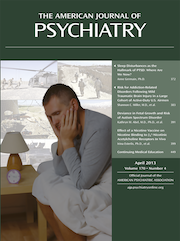Early Smoking Onset and Risk for Subsequent Nicotine Dependence: A Monozygotic Co-Twin Control Study
Abstract
Objective
Early onset of regular smoking is associated with an elevated risk for later nicotine dependence. Whether or not this association is causal is unknown and has substantial public policy implications.
Method
The authors used a monozygotic co-twin control study design. Pairs were selected from the Virginia Adult Twin Study of Psychiatric and Substance Use Disorders for discordance in age at onset of regular smoking. Nicotine dependence was measured by the Fagerström Test for Nicotine Dependence and level of craving.
Results
The authors identified 175 male-male and 69 female-female monozygotic twin pairs who differed by at least 2 years in age at onset of regular smoking. During their period of heaviest smoking, the twin who began smoking earlier had significantly higher Fagerström Test scores in both the male-male (Cohen’s d=0.20) and female-female twin pairs (d=0.26). Craving for cigarettes when unable to smoke was also higher in the early-onset member in both groups (male pairs, d=0.38; female pairs, d=0.25). The early-onset smoking twin did not differ from the later-onset twin in symptoms of alcohol or cannabis abuse or dependence, current alcohol use, or maximal level of cannabis, sedative, stimulant, or cocaine use.
Conclusions
Controlling for genetic and familial-environmental effects, age at onset of regular smoking predicted level of nicotine dependence. Consistent with the animal literature, these findings suggest that in humans, early nicotine exposure directly increases level of later nicotine dependence. These results should be interpreted in the context of the methodological strengths and limitations of the monozygotic co-twin design.



